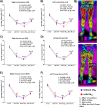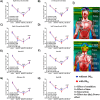Inspiratory muscles pre-activation in young swimmers submitted to a tethered swimming test: effects on mechanical, physiological, and skin temperature parameters
- PMID: 38472356
- PMCID: PMC10933374
- DOI: 10.1038/s41598-024-52312-z
Inspiratory muscles pre-activation in young swimmers submitted to a tethered swimming test: effects on mechanical, physiological, and skin temperature parameters
Abstract
Inspiratory muscles pre-activation (IMPA) has been studied to improve subsequent performance in swimming. However, the effects of IMPA on various parameters in swimmers are still unknown. Therefore, this study aimed to investigate the effects of IMPA on the mechanical parameters, physiological responses, and their possible correlations with swimming performance. A total of 14 young swimmers (aged 16 ± 0 years) underwent a 30-s all-out tethered swimming test, preceded or not by IMPA, a load of 40% of the maximal inspiratory pressure (MIP), and with a volume of 2 sets of 15 repetitions. The mechanical (strength, impulse, and fatigue index) and physiological parameters (skin temperature and lactatemia) and the assessment of perceived exertion and dyspnea were monitored in both protocols. The IMPA used did not increase the swimming force, and skin temperature, decrease blood lactate concentration, or subjective perception of exertion and dyspnea after the high-intensity tethered swimming exercises. Positive correlations were found between mean force and blood lactate (without IMPA: r = 0.62, P = 0.02; with IMPA: r = 0.65, P = 0.01). The impulse was positively correlated with blood lactate (without IMPA: r = 0.71, P < 0.01; with IMPA: r = 0.56, P = 0.03). Our results suggest that new IMPA protocols, possibly with increased volume, should be developed in order to improve the performance of young swimmers.
© 2024. The Author(s).
Conflict of interest statement
The authors below declare that they have no conflicts of interest that are relevant to the content of this article. The authors also certify that they have no affiliations with or involvement in any organization or entity with any financial or non-financial interest in the subject matter or materials discussed in this manuscript.
Figures





Similar articles
-
Tethered swimming can be used to evaluate force contribution for short-distance swimming performance.J Strength Cond Res. 2014 Nov;28(11):3093-9. doi: 10.1519/JSC.0000000000000509. J Strength Cond Res. 2014. PMID: 24796981
-
Reliability and Validity of Tethered Swimming Lactate Minimum Test and Their Relationship With Performance in Young Swimmers.Pediatr Exerc Sci. 2018 Aug 1;30(3):383-392. doi: 10.1123/pes.2016-0247. Epub 2018 Mar 27. Pediatr Exerc Sci. 2018. PMID: 29580176
-
Complex Network Model Reveals the Impact of Inspiratory Muscle Pre-Activation on Interactions among Physiological Responses and Muscle Oxygenation during Running and Passive Recovery.Biology (Basel). 2022 Jun 25;11(7):963. doi: 10.3390/biology11070963. Biology (Basel). 2022. PMID: 36101345 Free PMC article.
-
Determination of a quantitative parameter to evaluate swimming technique based on the maximal tethered swimming test.Sports Biomech. 2017 Jun;16(2):248-257. doi: 10.1080/14763141.2016.1231836. Epub 2016 Dec 21. Sports Biomech. 2017. PMID: 27998206
-
Metabolic responses at various intensities relative to critical swimming velocity.J Strength Cond Res. 2013 Jun;27(6):1731-41. doi: 10.1519/JSC.0b013e31828dde1e. J Strength Cond Res. 2013. PMID: 23449237 Review.
Cited by
-
Inspiratory muscle warm up improves 400 m performance in elite male runners.Sci Rep. 2025 Aug 7;15(1):28879. doi: 10.1038/s41598-025-14797-0. Sci Rep. 2025. PMID: 40775048 Free PMC article.
References
MeSH terms
Substances
Grants and funding
- 001/Coordenação de Aperfeiçoamento de Pessoal de Nível Superior
- 001/Coordenação de Aperfeiçoamento de Pessoal de Nível Superior
- 001/Coordenação de Aperfeiçoamento de Pessoal de Nível Superior
- 2019/20894-2/Fundação de Amparo à Pesquisa do Estado de São Paulo
- 2019/05115-7/Fundação de Amparo à Pesquisa do Estado de São Paulo
- 2020/11946-6/Fundação de Amparo à Pesquisa do Estado de São Paulo
- 2020/11946-6/Fundação de Amparo à Pesquisa do Estado de São Paulo
- 2020/11946-6/Fundação de Amparo à Pesquisa do Estado de São Paulo
- 308117/2018-2/Conselho Nacional de Desenvolvimento Científico e Tecnológico
- 309832/2021-7/Conselho Nacional de Desenvolvimento Científico e Tecnológico
- 2583/20/Fundo de Apoio ao Ensino, à Pesquisa e Extensão, Universidade Estadual de Campinas
LinkOut - more resources
Full Text Sources

